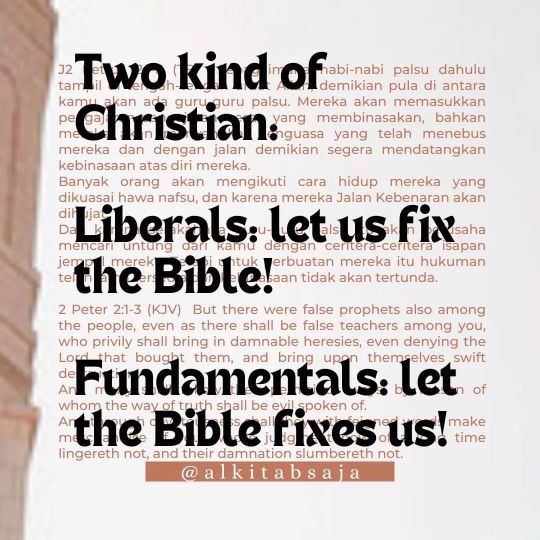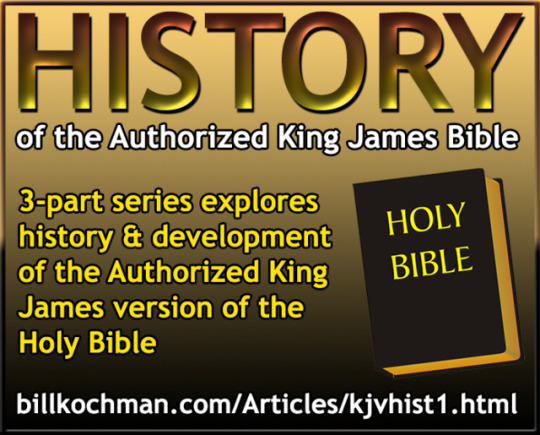#TextusReceptus
Explore tagged Tumblr posts
Photo

2 Petrus 2:1-3 (TB) Sebagaimana nabi-nabi palsu dahulu tampil di tengah-tengah umat Allah, demikian pula di antara kamu akan ada guru-guru palsu. Mereka akan memasukkan pengajaran-pengajaran sesat yang membinasakan, bahkan mereka akan menyangkal Penguasa yang telah menebus mereka dan dengan jalan demikian segera mendatangkan kebinasaan atas diri mereka. Banyak orang akan mengikuti cara hidup mereka yang dikuasai hawa nafsu, dan karena mereka Jalan Kebenaran akan dihujat. Dan karena serakahnya guru-guru palsu itu akan berusaha mencari untung dari kamu dengan ceritera-ceritera isapan jempol mereka. Tetapi untuk perbuatan mereka itu hukuman telah lama tersedia dan kebinasaan tidak akan tertunda. 2 Peter 2:1-3 (KJV) But there were false prophets also among the people, even as there shall be false teachers among you, who privily shall bring in damnable heresies, even denying the Lord that bought them, and bring upon themselves swift destruction. And many shall follow their pernicious ways; by reason of whom the way of truth shall be evil spoken of. And through covetousness shall they with feigned words make merchandise of you: whose judgment now of a long time lingereth not, and their damnation slumbereth not. 彼得后书 2:1-3 (CKJVSDS) 从前在百姓中有假先知起来,将来在你们中间,也必有假师傅,私自引进可咒诅的异端,连买他们的 主他们也不承认,自取速速的灭亡。 将有许多人随从他们邪淫的行为,便叫真理的道因他们的缘故被毁谤。 他们因有贪心,要用捏造的言语在你们身上取利;他们的刑罚,自古以来并不迟延;他们的咒诅也不打盹。 #alkitabiah.org #matikemana.com #alkitabsaja #anabaptists #fundamental #textusreceptus #liberals #biblecritics #criticaltext https://www.instagram.com/p/Ccz8A1hFsiv/?igshid=NGJjMDIxMWI=
#alkitabiah#matikemana#alkitabsaja#anabaptists#fundamental#textusreceptus#liberals#biblecritics#criticaltext
0 notes
Photo

Is the KJV Bible the Inerrant Word of God?
My original BBB Blog post is here: https://www.billkochman.com/Blog/is-the-kjv-bible-the-inerrant-word-of-god/.
Post tags: #Apocrypha, #Bible, #BillKochman, #BillsBibleBasics, #Christian, #Church, #ChurchOfEngland, #DesideriusErasmus, #DivineInspiration, #Doctrines, #Ekklesia, #Inerrant, #Inspired, #KingJames, #Kjv, #RomanCatholic, #TextusReceptus, #Translations, #WilliamTyndale
#apocrypha#bible#bill kochman#bills bible basics#christian#church#church of england#desiderius erasmus#divine inspiration#doctrines#ekklesia#inerrant#inspired#king james#kjv#roman catholic#textus receptus#translations#william tyndale
0 notes
Text

What is Textual Criticism?
By Bible Researcher Eli Kittim
Definition of Textual Criticism
Textual criticism is a branch of textual studies, which comprise various disciplines whose aims are to transcribe, edit, or annotate texts and documents. Textual criticism is a branch of philology (the study of language in oral and written historical sources) and literary criticism, which is interested in the identification of textual variants or different versions of books or manuscripts. Simply put, textual criticism is a method by which scholars try to determine what an original text actually said. Whereas *higher criticism* is concerned with the origins of the original text (e.g. its authorship, date & place of composition), *lower criticism* (i.e. “textual criticism”) seeks to determine the original linguistic-grammatical structure of the text.
The Process of Textual Criticism
In ancient times, prior to the 15th century invention of the printing press, scribes were usually employed to copy documents by hand. During the copying process, however, intentional and unintentional alterations were made, the former sometimes due to political or religious reasons, the latter out of sheer misunderstanding or negligence. Thus, the aim of the textual critic is to understand the historical composition and transmission of a text and its variants. In so doing, the textual critic may be able to produce a so-called “critical edition,” which is a scholarly edition of a corrected text in conjunction with a critical apparatus that records editorial changes, names of manuscripts, and the like.
As already noted, prior to the printing press, literary works were copied by hand and, as expected, copyists produced different variations at certain places in the text. Given that different scribes introduced various errors, the task of textual reconstruction usually requires a selection of readings gathered from multiple sources. Such an edited text is called “eclectic.” In contrast to the multiple-sources approach, however, a number of textual critics will only seek to identify the best extant text with regard to textual reconstruction. When considering various documents (i.e. “witnesses”) of an original text, the linguistic or grammatical differences or variations are called “variants” or “variant readings.” So, through various comparative methods, textual criticism tries to ascertain how the variants were introduced into the text——whether accidentally (via duplication or omission) or intentionally (by way of censorship or harmonization)——as scribes copied from the original autograph and then transmitted these writings across the then-known world.
Guidelines of Textual Criticism
We have hundreds of extant copies of ancient works, thousands as far as the Bible is concerned, but their relationship to the original text is often unclear. Thus, in order to ascertain which readings are faithful (most closely related to the autograph), textual scholars typically debate which sources appear to be derived from the original text. Typically, when there’s no known original manuscript but only several extant copies or versions, certain guidelines/methods of textual criticism are employed in an attempt to *reconstruct* the original text (i.e. the autograph) as faithfully as possible. In order to determine the most accurate readings of a text, scholars have devised certain guidelines (i.e. “canons”) of textual criticism. Without going into great detail, one of the most prominent rules was established by Koine-Greek scholar Johann Albrecht Bengel (1687–1752), who also produced an edition of the Greek New Testament. In his commentaries, Bengel (aka Bengelius) established the rule that “the harder reading is to be preferred.” That’s because the most difficult reading is probably the one that is less tampered with. A number of these guidelines, which were initially designed for Biblical textual criticism, are now applied to all literary texts that have been exposed to errors of textual transmission!
Conclusion
Textual Criticism is important in determining the original words of texts. But it’s especially important in Bible studies with regard to establishing “the word of God” (Hebrews 4:12), that is, the things that God originally said and revealed in holy writ, since it is said therein that “All Scripture is God-breathed” (2 Timothy 3:16)!
—
#textualcriticism#TextusReceptus#Byzantinetext#MajorityText#variants#Alexandriantext#literary criticism#philology#Highercriticism#Lowercriticism#εκ#criticaledition#textualreconstruction#eclectictext#variantreadings#witnesses#autographs#canons#JohannAlbrechtBengel#elikittim#thelittlebookofrevelation#ελικιτίμ#το μικρό βιβλίο της αποκάλυψης#ek#2Timothy3v16#thewordofgod#Biblestudies#kingJamesonly#receivedtext#Nestle_Alandtext
4 notes
·
View notes
Photo

History of the Authorized King James Bible
My original BBB Blog post is here: https://www.billkochman.com/Blog/history-of-the-authorized-king-james-bible/.
Post tags: #Bible, #BillKochman, #BillsBibleBasics, #BloodyMary, #Christian, #DesideriosErasmus, #GreatBible, #History, #JohnRogers, #JohnWycliffe, #KingJames, #Kjv, #MartinLuther, #MatthewBible, #MylesCoverdale, #RomanCatholic, #TextusReceptus, #ThomasCrammer, #WilliamTyndale
#bible#bill kochman#bills bible basics#bloody mary#christian#desiderios erasmus#great bible#history#john rogers#john wycliffe#king james#kjv#martin luther#matthew bible#myles coverdale#roman catholic#textus receptus#thomas crammer#william tyndale
0 notes
Video
instagram
#FBC in the #Mornin' #TextusReceptus #KingJamesVersion #ReinaValera1960SantaBiblia #ChildrenOfTHeMostHigh #GNite
0 notes
Video
instagram
Water Balloon Fight Sunday #HumboldtPark #Chicago #FBC 89-10 #Christians #TextusReceptus aka #KJV aka #ReinaValera1960SantaBiblia
0 notes